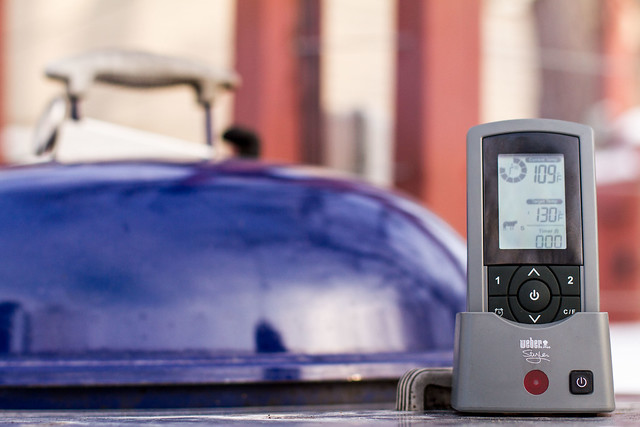Standing Rib Roast: What's on the Grill #297
One of my all-time favorite grilled meals is a standing rib roast, more commonly known as prime rib. While the word "prime" tends to immediately evoke the grade of cut (prime, choice, select, etc), in this case, prime rib refers to the type of cut. Prime rib is one of the 8 primal cuts of meat. These primal cuts are the sections first removed during the butchering of an animal's carcass.
So, even though I picked up a two bone standing rib roast graded as choice, the USDA says I can still call it prime rib, even though it's not USDA Prime.
In the end call it what you want. I will call it awesome.

Grilled Standing Rib Roast
by Another Pint Please
2 bone standing rib roast - about 5 lbs
4 cloves of garlic, minced
1/4 cup fresh rosemary, finely chopped
2 T olive oil
1 T kosher salt
2 T freshly cracked black pepper
Butcher's twine
While a standing rib roast may seem daunting to grill because of its price, it is, in fact, dead easy. The meat can serve as a canvas for any combinations of flavors. While I love the fresh aroma of rosemary and the pungency of garlic, anything will work. In fact, this is really less recipe and more process.
While great results can be had with a boneless roast, this is a standing rib roast, so for me those bones are a must. From a scientific level, there is some debate as to whether or not the bones add anything to the meat. Whether or not they help or hinder is up to you and your tastes. I almost always leave them on the roast, versus trimming them off.
Remove the rosemary from the stems and finely chop.

Do the same with the garlic cloves.

Mix the garlic and rosemary in a small bowl and add in the olive oil.
The Roast
I asked the butcher for 2-3 bones, and I got 2 bones and a sliver of a third, so my request was pretty much spot on.

To ensure even grilling, it's a good idea to truss the roast.
When trussing, I attach the twine right next to the bones, with one piece per bone. Since I had almost three bones, I used three pieces of twine.

With the roast trussed, season all over with salt and pepper. Next, cover with the rosemary and garlic mixture.

The Grill

Prepare the grill for indirect medium heat. On the kettle, I placed charcoal to both sides and added a drip pan to the middle.
If it's cold outside as it was for me, add a little more fuel to battle the wintery weather.
After the charcoal is going, be sure to preheat the grill for at least 15-20 minutes.
While the roast is going to cook indirect, it's important to start off with a good sear. Place the meat directly over the coals and allow each side to sear (in essence, all three sides, minus the bones) for just a few minutes each.

With the searing complete, move the roast to the indirect part of the grill. For added flavor, drop a few wood chunks onto the hot coals. I popped in some hickory.
Close the lid, and allow to cook. No peaking!
Note, the key to a successful rib roast is grilling to the right internal temperature. In this case 130 F for medium rare. An instant read thermometer, or even better, a remote thermometer, is a requirement.

The easiest way to screw up a roast is to overcook it.

When the thermometer reaches 130 F, remove it from the grill, tent it with aluminum foil, and allow it to rest.
And of course, while the meat is doing its thing, be sure to grill some sides.

A great dinner means a great big beer. Enter Great Divides Oak Espresso Oak Aged Yeti. Aggressive, bitter, and utterly delightful.

Speaking of utterly delightful, the roast was great. Served along side some pan fried vegetables, and my can't get enough of grilled romaine, the rib roast lived up to the hype.

Next time a big meal beckons you don't let the specter of grilling a prime rib scare you. It will be everything you want, and more.

